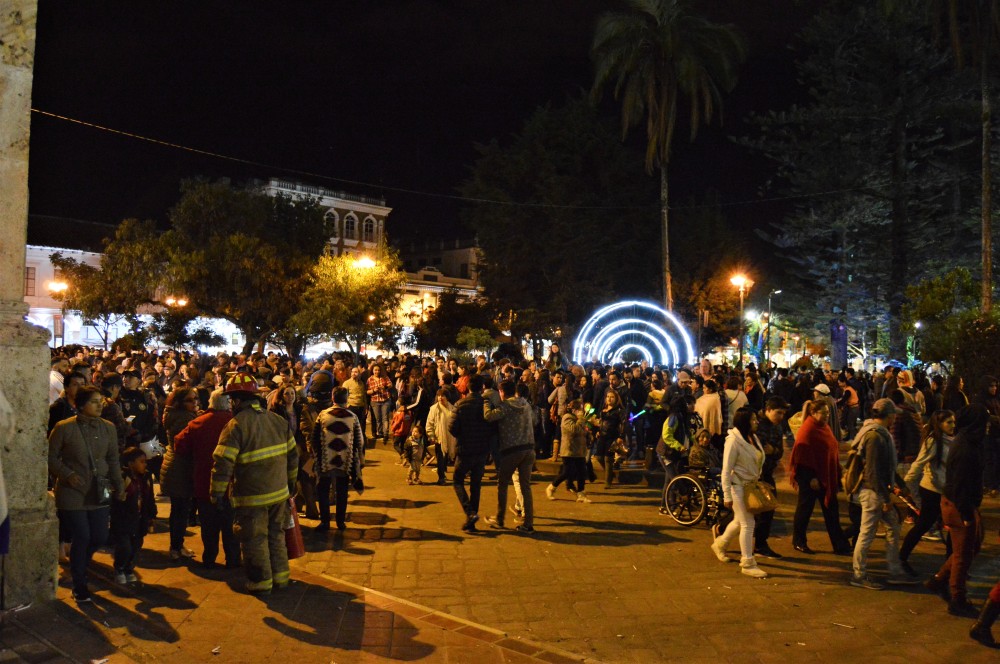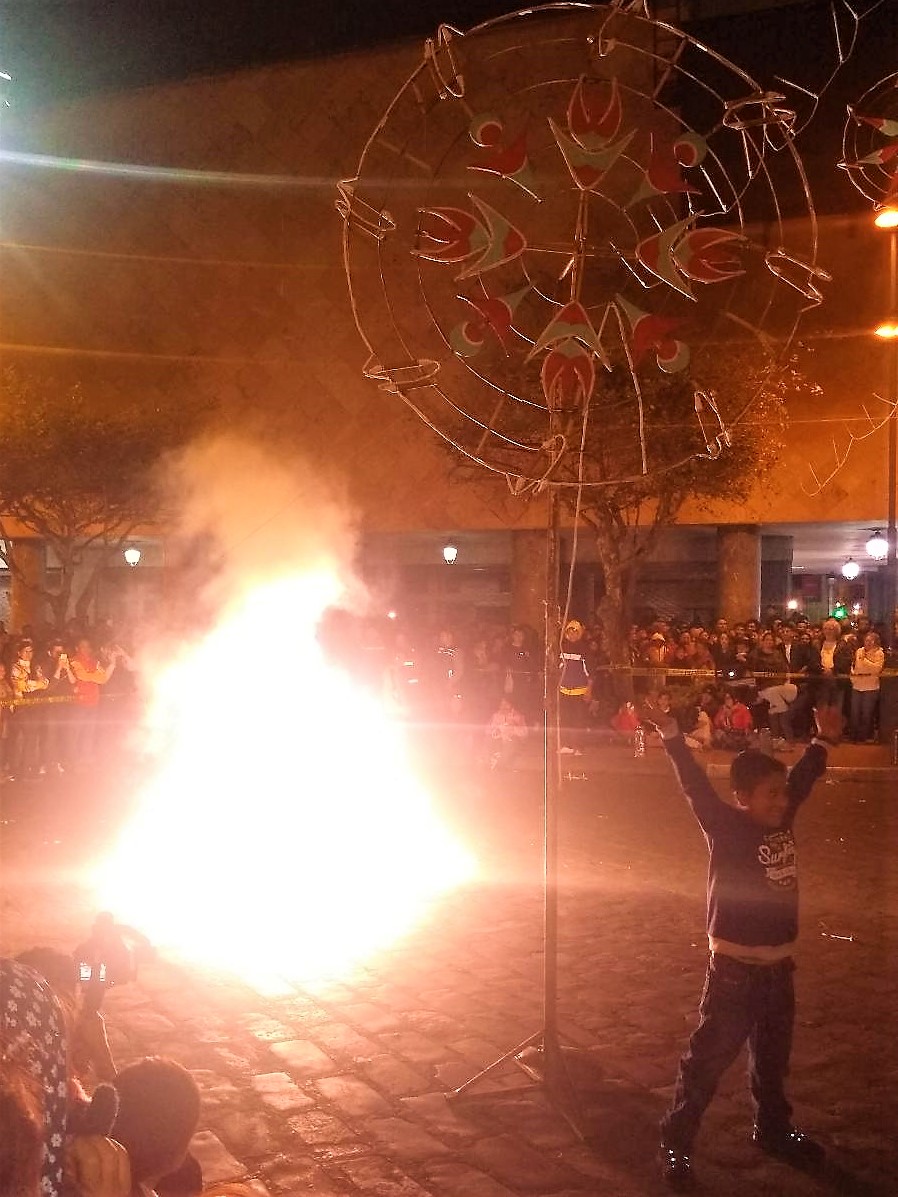In a culture filled with tradition and festivals, Cuencanos go all out to celebrate Corpus Christi.
The Christian festival is one of thanksgiving, tracing its history to the 1500s through Spanish heritage to its indigenous roots. Hundreds of years ago, Incans showed their appreciation for a good harvest by celebrating the mythological Incan goddess Pacchamama, or Mother Earth, and sun god Inti. Somewhere along the way, the Roman Catholic Church redefined the festival to be one that recognizes the belief that during Mass, bread and wine are changed into the body and blood of Jesus Christ. Corpus Christi is Latin for the body of Christ. Many Cuencanos celebrate both aspects of the festival.
Current-day Corpus Christi takes place 60 days after Easter and generally lasts a week. In Cuenca, where celebrations centered around our central Parque Calderon, vendors and merchants extended the festival two additional days by pitching in for additional fireworks displays. Roads around the park are closed to traffic nightly and hundreds of people pour into the streets.

According to the Cuenca Office of Tourism, the commemoration of Corpus Christi begins with a proclamation in the streets that ends at the Cathedral de La Inmaculada, also known as the New Cathedral. Here the liturgy is solemnized, followed by a presentation in the streets of the first burning castle, or tower of fireworks. Devotees are given the opportunity to worship at the blessed display inside the Cathedral. The Sacred Host, or consecrated communion bread, remains on display for seven nights and seven dawns. For this the festival is also known as “Septenario,” where “sept” refers to seven.
The family-friendly atmosphere is punctuated with human statues, clowns and homemade carnival games. Vendors hawk everything from whistles and LED toys to handmade bracelets and tiny toy animals. The highlight, of course, is the famous candy produced specifically for this festival. At least 125 tents lined the park on all sides, each displaying mounds of colorful sweets more spectacular than the first.
While the delicacies are beautiful, the selection is overwhelming. How can you possibly decide? For a few dollars, you can take basket and pick and choose to your heart’s content. Of course, you may have to fight swarms of honey bees to get to the products you want. The longer the festival goes on, the more the industrious little bees are drawn to the sugar-laden tables. According to the tourism office, sweets were first distributed by Spanish noble women as gifts to those who lived nearby their homes. They were also given to women in convents and to the Cholas, the indigenous women known by their embroidered and sequined skirts, and became a means to prove participation in the Septenario. Eventually, the recipes slipped out into the general population and today, families take great pride in their own concoctions of candies.
Each night features new folkloric dancers and traditional music. I never cease to be amazed at the agility of Cuencano dancers who navigate the uneven cobblestone streets with ease. Each dance tells a story and is almost always accompanied by props, such as Ecuadorian hats, baskets, flowers, scarves or crates. Most nights, military bands perform as well.
Corpus Christi ends with a procession from the New Cathedral, spilling out hundreds of parishioners who leave rose petals strewn in their wake. In a solemn march around the plaza, onlookers join the parade behind the priest and his contingent. Then comes the grand finale – the burning of the castles. Handmade towers of bamboo, some stretching as high as 40 feet, are placed in the street. The towers are artistically decorated and strategically adorned with swirling pinwheel pyrotechnics, dazzling giant sparklers and colorful rockets timed to go off in rapid succession. The burning of the castles, signifying the end of that night’s celebration, is sponsored by church congregations, civic organizations or individual families.
I was surprised by the location of the opening night’s incendiary display. Fireworks were attached to every window, atop the roof and along the front of the alabaster and marble New Cathedral. The church isn’t that old, having opened in 1975, but it took nearly 100 years to build it. And it’s quite possibly the most recognizable Cuenca landmark, with its trio of domes covered by brilliant blue Czechoslovakian tiles. It was with a bit of fear and awe that I watched as sparks flew off the church. Thankfully, there was no need for the firemen who stood at the ready.
On another night, bystanders angling for the front-row view of the burning towers pressed against some of the police warning tapes until they broke. People crowded to within 20 feet of the burning displays while officers tried in vain to push them back. Again I was reminded of a major difference between Ecuador and the United States. You don’t sue anyone if you get hurt here. It is your responsibility not to get hurt and, if you do, there is no one to blame. Shockingly, a mother standing near me sent her 8–year-old son repeatedly under the tape to stand next to an exploding tower.

As the sparks of the last tower burned out, this year’s celebration of Corpus Christi came to an end. Well, you still hear fireworks. But this town is like that. Cuencanos love a good light show. The louder, the better.





















You look good like you are adapting quite well. Enjoy it sounds wonderful
LikeLiked by 1 person
Thanks! And thanks for reading!
LikeLiked by 1 person
Reading your stories makes me feel like I am there. Love you.
LikeLiked by 1 person
Come on down!
LikeLiked by 1 person
Another wonderful chapter in your current adventure. Thanks for sharing your adventure with us!❤️
LikeLiked by 1 person
Thanks for reading and commenting and coming along for the ride!
LikeLike